Last Updated on March 31, 2024 by foxintheforest
Arguably one of the greatest marvels of the natural world, the Grand Canyon in winter is a sight to behold. Seeing this red rock marvel carved by years of erosion dusted in snow is a real treat. And the best part? There are fewer crowds too!
I’ve been exploring the American Southwest for the better part of 13 years and it’s always a treat when I get the chance to head to the Grand Canyon. This complete guide to the Grand Canyon in winter gives you expert advice about how to make the most of your off-season visit.
About this Guide to the Grand Canyon in Winter
Inside this expert’s guide to the Grand Canyon in winter you’ll get insider info on how to explore like a pro, not a tourist. Inside you’ll find:
- Practical info about visiting the Grand Canyon during winter
- Info about weather and Grand Canyon winter temperatures
- Things to do in the Grand Canyon during winter
- Where to stay
- What to wear
- Additional planning resources
Practical Info About Visiting the Grand Canyon in Winter
First up, the North Rim of the Grand Canyon is closed to vehicle access during the winter.
Accessing the park from the north end between October 15th and May 15th is extremely difficult and requires some advanced knowledge of traveling over snowy terrain. Best not to visit this part of the Grand Canyon in March.
So, that may help you decide between the Grand Canyon North Rim vs. South Rim.
However, the South Rim of the Grand Canyon is open year-round and is very accessible. In order to access the South Rim, you’ll have to head to either the South Entrance Station or East Entrance Station. Here are a few practical tips:
Entry fee is $35 per day (no ins and outs) or free with the America the Beautiful Annual Parks Pass – a screaming deal if you plan on visiting for multiple days or seeing more than 2 national parks in a 12-month period.
The park is not really dog-friendly. Dogs are not allowed on hiking trails and can only stay on roads or paved walkways. They must be leashed. Heatstroke is not an issue in the Grand Canyon in the winter, but it’s not really fair to leave your pup in the car either.
Services can be limited in the park during the winter. Come prepared by packing a windshield scraper and fluid, extra food and water, blankets, extra lawyers and booster cables.
Crowds are still existent, but far fewer in the winter. It’s the second most popular national park in the US (right behind Yellowstone), so you’ll definitely see people, even in winter, but it’s a far cry from the jam-packed viewpoints and trails of summer.
Pro Tip: There is limited cell service on the South Rim, but don’t rely on it if something goes wrong!
Map of the Grand Canyon
Get oriented with this map of the Grand Canyon. The South Rim is everything south of the Colorado River.
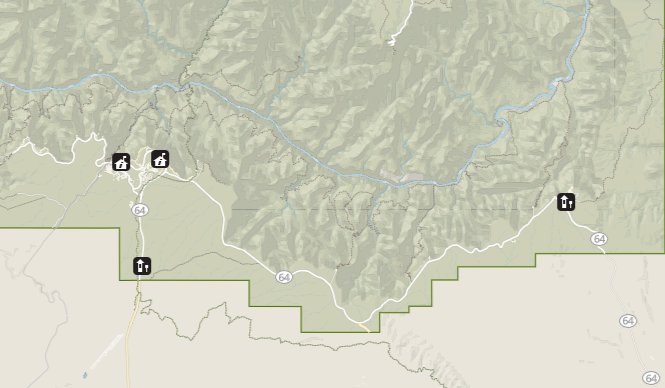
Does the Grand Canyon Get Cold in the Winter?
Yup, it sure does! It even snows (if you’re lucky). Temperatures are relatively mild by winter weather standards, usually hovering in the 40s during the day. However breezy canyon rims can make it feel quite cold, so come prepared.
Snowstorms typically drop a few inches of the white fluff. Once the skies clear, it’s jaw-dropping. But don’t fret if you hate the cold, when the sun is shining and the wind is still, it’s rather pleasant during the winter.
What to Expect From Grand Canyon Winter Weather
The weather in the Grand Canyon in the winter can actually be more pleasant than the searing desert heat of the summer. The winter high temps up on the South Rim average in the low-to-mid 40s and can reach into the 60s down in the bottom of the canyon. But snowstorms and cold fronts can quickly put a kink in your plans, so you’ll definitely want to check the forecast before your trip.
Snow hits the North Rim the hardest, with an annual snowfall average of 142 inches a year. This is why the North Rim is closed to vehicles in the winter. The South Rim average snowfall is significantly less at 58 inches. Snow rarely makes it down to the inner canyon, with Phantom Ranch averaging less than an inch of snow each year.
In general, here is what you can expect from Grand Canyon winter weather each month:
Grand Canyon in December
In the Grand Canyon in December, you can expect an average high temp of 45°F at the South Rim. The evening temperatures will dip into the teens. You will most likely encounter snow in December, especially later in the month.
Is December a Good Time to Visit the Grand Canyon?
Yes! Winter holidays in the Grand Canyon are a real treat. What better way to experience the magic of the season than with a snow-dusted view of the mighty Grand Canyon? Crowds are typically not too crazy but expect to have some company at popular viewpoints and on busy trails.
Weather in the Grand Canyon in January
Weather in the Grand Canyon in January is definitely the deep of winter, but the average high temperature still hovers in the mid-40s at the South Rim. Be prepared for snow, since January sees the highest snowfall averages in the Grand Canyon.
Pro Tip: If you’re into photography, January is an excellent time to pack up your tripod and photograph the Grand Canyon in winter.
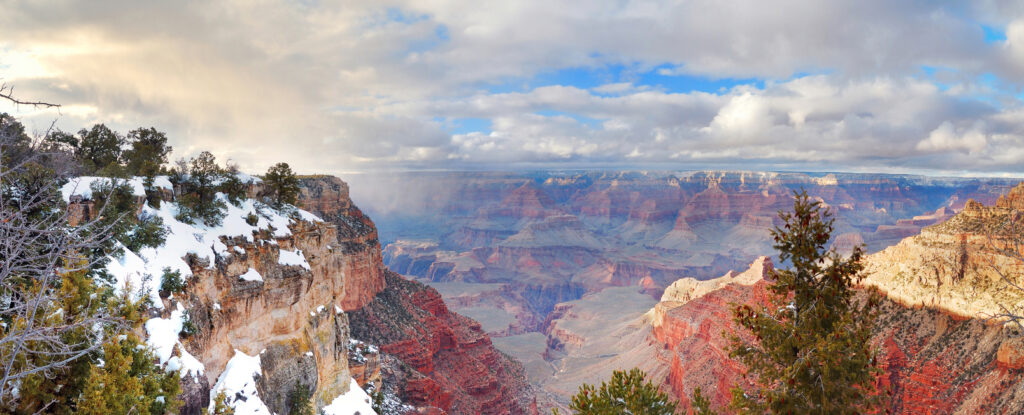
Visiting in February
February weather is very similar to January weather in the Grand Canyon, with high temps on the South Rim averaging about 46°F. Expect a fair amount of snowfall, although potentially a few inches less than in January.
March in the Grand Canyon
The winter weather begins to warm up in March as spring approaches. The average daily high on the South Rim edges up to 51°F, and the inner canyon will get into the 70s. Of course, it will probably still snow, but when it’s snow-free, the conditions in the Grand Canyon in March can be quite pleasant.
Daylight Hours in the Grand Canyon in Winter
Like with most places in the United States, the number of daylight hours that you encounter at the Grand Canyon lessens in the winter.
Therefore, expect to encounter shorter days (or less daylight) towards the end of December, when the sun rises around 7:00 am and sets around 5:00 pm.
However, in general, the sun rises and sets in:
- December Sunrise: 7:20 am – 7:40 am
- December Sunset: 5:15 pm – 5:25 pm
- January Sunrise: 7:40 am
- January Sunset: 5:25 pm – 5:40 pm
- February Sunrise: 7:00 am to 7:30 am
- February Sunset: 5:55 pm and 6:30 pm
That being said, you’ll definitely still have enough time to see all the things you want to see.
But, do try to make the most of the daylight you have by getting up with the sun and returning to your hotel once it gets dark.
Pro Tip: Please remember that from November through March, there is a one-hour time difference between Las Vegas and the Grand Canyon since Nevada uses Daylight savings time and Arizona does not.
So, if it’s 8:00 am in Las Vegas then it will be one later at the Grand Canyon and you should plan accordingly.
What are Crowds Like in the Grand Canyon in the Winter?
If you’re looking to avoid crowds in the Grand Canyon, winter is the ideal time to visit the Grand Canyon to find the solitude you seek. January and February are the months with the lowest levels of park attendance throughout the year.
Backcountry permits are much easier to get in the winter, so you can really head out into the park alone if you’ve got some experience backpacking in the snow. Since the North Rim is closed to vehicles during the winter, if you make the effort to snowshoe or hike into the area, you will certainly find seclusion.
Just be aware that lines to get into the South Rim can still be ridiculously long in the winter.
In fact, wait times to get into the South Rim Entrance can be upwards of two hours long – especially during the holidays and on the weekends. So, it is always best to visit early and to avoid busier times of the week.
Are Grand Canyon Roads Open in the Winter?
The only roads that are open in the Grand Canyon are those on the South Rim. These typically remain open all year long, unless there’s inclement weather.
That being said, the major road (SR64) from Williams, AZ to Grand Canyon Village is basically always open. This is where you’ll probably enter the park and where you can find famous viewpoints and the visitor’s center.
In contrast, Desert View Road (going towards Cameron) will often close when snow hits the area. Sure, they try to clear the road ASAP but don’t be shocked if this route is closed in the winter.
Now, Hermit Road is another popular thoroughfare in the South Rim that will take you to several iconic viewpoints.
In fact, this road is so popular that it is only open to shuttles in the summer. However, come winter, the road is not plowed regularly since it is a small local road.
Therefore, while you can use a private vehicle here in winter, don’t be surprised if the road is closed because of snow.
In general, always check the official Grand Canyon website for the most up-to-date information on road closures before you visit.
Winter Closures in the Grand Canyon
Even though the Grand Canyon is open year-round, winter closures can happen and many of the summertime facilities (as well as activities) shut down.
North Rim
While the South Rim stays open year-round, the North Rim of the Grand Canyon closes during the winter months. And so do some of the best Grand Canyon viewpoints.
This closure takes place in stages – facilities and services at the North Rim close each year on October 16, and the road to the North Rim closes on December 1st (or potentially earlier if there is a big snowstorm).
From October 16 through December 1st, you can still drive to the North Rim for day use, but the Visitor Center will be closed. The general store will continue to sell goods while supplies last, and limited water will be available at the North Rim Backcountry Information Center after October 31st.
The North Rim Campground will accept reservations through October 31st. On November 1st, the campground will close but can still be used for winter camping with a backcountry permit. To access the campground in the winter, you need to either hike from the South Rim or 45 miles from Jacob Lake.
You can also access the Grand Canyon through the West Rim, which is on the land of the Hualapai Tribe. This entrance is not part of the National Park System, so there is a separate admission fee, and National Parks passes are not accepted.
Shuttle Buses
The shuttle buses operate on a modified schedule during winter in the Grand Canyon. The Village Route, Kaibab Route, and Hiker’s Express shuttle continue running, but with less frequency and fewer stops.
The Hermit Road shuttle suspends service completely in December, January, and February, and private vehicles are allowed on the road instead.
Activities
During the winter months, a lot of touristy activities are not available. River trips are not advised and donkey/horse rides aren’t operating. Also, if it’s windy, the choppers won’t fly either (for hikers and those that want some quiet – this is a good thing!).
However, you can check out epic sunset tours of the Grand Canyon and see if they run. You can also do cool Grand Canyon tours from Phoenix.
Is it Ok to Visit the Grand Canyon in Winter?
Yes, the Grand Canyon is a great place to visit at any time of year. And while there will still be people there in the winter, it will be a lot less crowded than it is during the summer.
Just be aware that the North Rim does close during the winter. In contrast, the South Rim is open all year long and the roads are typically open.
Just be sure to check the weather regularly if you plan to visit the Grand Canyon in winter since weather, and visibility can change rapidly.
Pro Tip: Plan multiple days in the park. This way, if the weather is less than ideal, you can wait for it to change and eventually enjoy some amazing views of the canyon.
Is It Worth Seeing the Grand Canyon in the Snow?
Yes, it is definitely worth seeing the Grand Canyon in the snow. A thin blanket of snow adds a certain magic and charm to all of the sweeping panoramas that the South Rim of the park has to offer.
What About the Views of the Grand Canyon in the Winter? Can You See Anything in the Snow?
Yes, you can definitely enjoy amazing, unobstructed views of the Grand Canyon in the winter.
However, due to local weather conditions, be prepared for clouds and mist that can reduce visibility to almost nothing.
Typically, this happens during a snowstorm. So, if there is a snowstorm in the forecast definitely reconsider your trip since you won’t be able to see anything and the roads can be extremely dangerous.
What to do if there is a Snowstorm in the Forecast?
The good thing about snowstorms in and around the Grand Canyon is that they move through the area pretty quickly and are always announced ahead of time.
Therefore, you should have time to rearrange your schedule so that you can visit lower-elevation areas like Sedona, Antelope Canyon, Monument Valley, and even the area around Las Vegas.
Alternatively, you could always book a stay at a nice resort inside the park. Many come with indoor pools that are fun to use should the weather outside turn nasty.
What is there to do at the Grand Canyon in winter?
There are plenty of things to do in the Grand Canyon in winter. So, if you plan to spend at least two days in the park then you could hop on the Dessert View Drive and use this scenic route to access some of the best viewpoints in the Grand Canyon.
Then, when you’re en route to Hermits Rest you could explore the interpretive trail near Mather Point. You could also try a bit of hiking and do the Rim to Rim Trail, Bright Angel Trail, South Kaibab Trail, and the Rim Trail from Bright Angel Lodge.
Pro Tip: Try to create a flexible schedule so that you can change your itinerary if the weather turns bad. Also, make sure your hotel offers free cancelation in case the weather changes at the last minute.
Things to Do in Grand Canyon National Park in Winter
Despite the closure of the North Rim, you’ll still find plenty of things to do in the Grand Canyon in winter.
Can You Hike into the Grand Canyon in Winter?
Absolutely! Hiking is a great way to experience the Grand Canyon in the winter. In fact, you won’t have to worry too much about overheating on the trails during the colder months.
Though the North Rim trails are closed, the Grand Canyon trails starting from the South Rim remain open year-round. Here are some of the best hikes in the Grand Canyon in the winter:
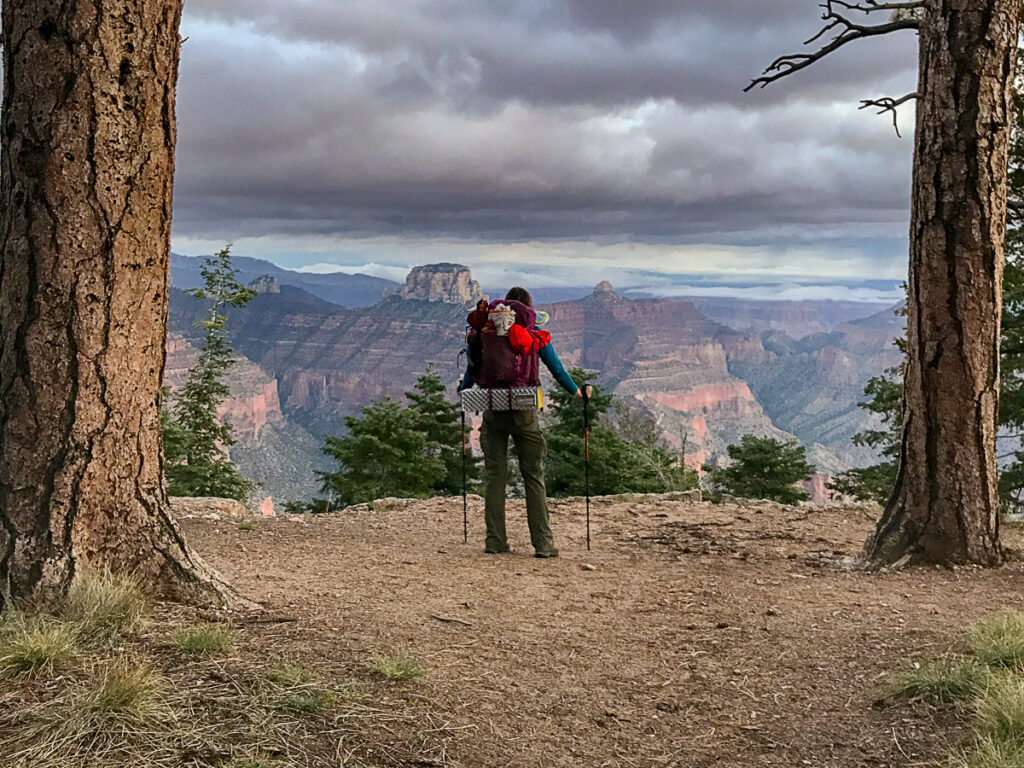
Rim Trail
The Rim Trail, like its name suggests, runs along a section of the South Rim. Because you don’t go into the canyon itself, there’s not much elevation gain, making it a mellow winter hike.
The entire trail is nearly 13 miles one way, and in peak season, there is a shuttle to take you back to the start. In the winter, the shuttle doesn’t go past Grand Canyon Village, so it’s probably best to just hike a section of the trail and then turn around.
South Kaibab Trail
This is one of the most popular trails in the Grand Canyon, and it’s especially nice in winter since almost all of it is in the sun. The first quarter-mile, known as The Chimney, stays shaded though, so it gets extremely ice-covered in the winter.
You can take the South Kaibab Trail all the way down to the river if you get a backcountry permit to camp overnight. Otherwise, it is recommended that you turn around at Skeleton Point (about 3 miles in) for a day hike.
Pro Tip: Pack traction and hiking poles to help you with the icy sections.
Hermit Trail
Due to its southern exposure, Hermit Trail is an excellent winter trail with less snow and ice than most other trails. This trail is quite difficult though, with a very steep (almost 2,000 feet) drop-down in the first 2.5 miles.
The entire trail is nearly 20 miles round trip, but you can turn around at or before Breezy Point for a day hike. Hermit Trail is really only recommended for experienced hikers who are aware of important desert hiking tips.
Bright Angel Trail
Bright Angel Trail is the most popular trail in the Grand Canyon. It’s nice to hike it in the winter without the crazy crowds. However, the upper section of the trail is north-facing and can hold packed snow and ice throughout the winter.
For a day hike, it is recommended that you don’t go farther than Indian Garden (9 miles round trip). If you are extremely experienced and check in with a ranger first, you might be able to make it to Plateau Point before turning around (12 miles round trip).
Pro Tip: One of the most important winter hiking tips is to bring microspikes or other traction to safely navigate the potentially icy and slippery trails in the Grand Canyon in winter.
Check Out the Visitor Center
Located right near Mather Point and next to some of the park’s main parking areas, the visitor’s center is a great place to stop if you need trail maps, information about the park, or want to chat with a ranger.
Plus, if you want to escape the cold you can watch a 20-minute video entitled, “Grand Canyon: A Journey of Wonder” or explore some of the exhibits that go into detail about the Grand Canyon.
You can also shop for souvenirs at the store across the street or head to Bright Angel Bike Rentals since the cafe here serves some of the best coffee in the area.
Enjoy Sunset at Mather Point
Honestly, sunset at the Grand Canyon is magical during any season of the year. However, winter is extra special since the stunning natural landscape here is dusted in a fine layer of snow.
Add in a sky filled with a kaleidoscope of colors and you have a truly one-of-a-kind experience that is not to be missed while enjoying the Grand Canyon in winter.
But, the best part? Shorter days mean that sunset is early. So, you can grab yourself a nice dinner after stopping for sunset views at Mather Point. However, Yavapai Point and Hopi Point are rad places to watch the sun sink beneath the horizon too.
Pro Tip: Don’t leave right when the sun sets. Instead, stick around for a few minutes and see what kind of colors light up the sky.
Go for a Scenic Drive
One amazing aspect of the Grand Canyon in winter (December, January, & February) is that Hermit Road is open to public traffic. The rest of the year, the road is only open to park service shuttle buses, pedestrians, and cyclists. This means you’ll get to enjoy one of the most scenic drives in the US from your own vehicle.
Hermit Road boasts some of the most spectacular Grand Canyon viewpoints with 9 canyon overlooks. Check out The Abyss for a steep vertical view into the canyon or Pima Point for a glimpse of the Colorado River.
Pro Tip: For sunset or sunrise, head to Hopi Point or Mohave Point, both of which have extensive views into the canyon and of the Colorado River.
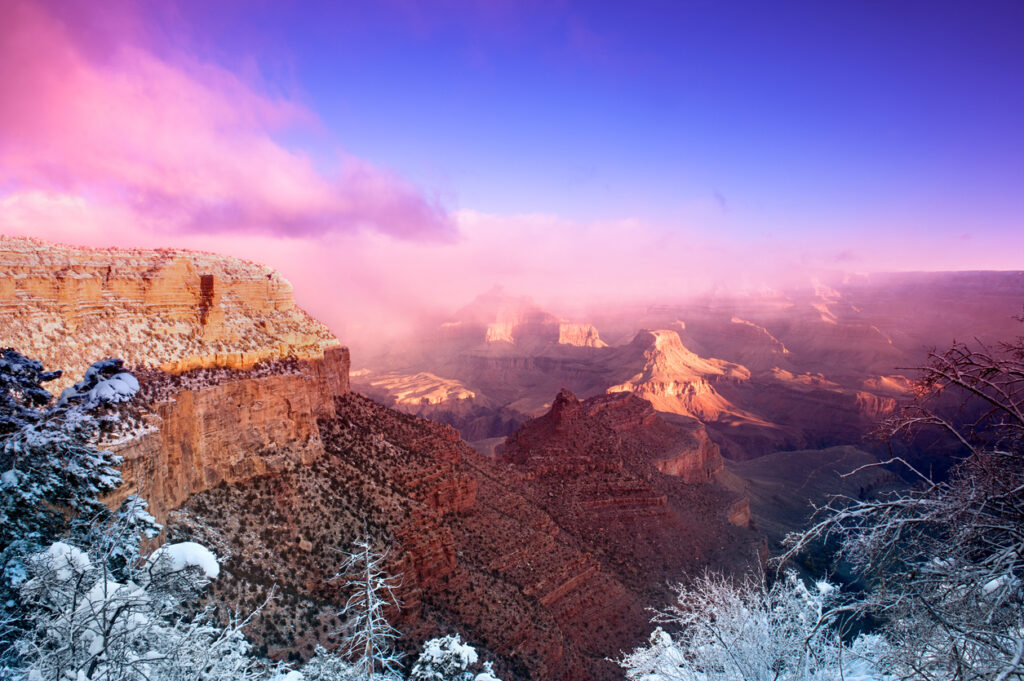
Yavapai Museum of Geology
If the Grand Canyon winter weather gets to be a little too much, you can take shelter from the cold and snow in the Yavapai Museum of Geology.
The museum is located between the Visitor Center and Grand Canyon Village, and it features large picture windows that look out over the canyon. You can also learn about the geology that formed the Grand Canyon and see a topographical relief map of the whole canyon.
Winter Camping in the Grand Canyon
If you’re not a planner and can handle the cold, winter camping in the Grand Canyon is an amazing experience. It doesn’t require the many months in advance reservations you need to get a campsite during peak season.
Some of the campgrounds in the Grand Canyon are closed in the winter. But you can camp at Mather Campground on the South Rim.
Or get a backcountry permit and backpack into Bright Angel Campground deep at the bottom of the canyon. You can also cross-country ski, snowshoe, or hike to the North Rim Campground for a full winter experience.
With all these activities – and without the extreme desert heat of the warmer months – the Grand Canyon is really one of the best national parks to visit in the winter.
Use Shuttles to Access Viewpoints in Inclement Weather (or Self-Drive Under Good Conditions)
Winter in the Grand Canyon sometimes means less than stellar weather. So, if conditions are not ideal for driving then you start with Mather Point since it’s just a short walk from the visitor center.
From here you can use a shuttle that will take you along either the Village Route (aka Blue Route) or the Kaibab Rim Route (aka Orange Route). It’s a great option if you don’t want to drive through the snow since the shuttles are free and depart every thirty minutes.
Then, once on the shuttle, you can use the Kaibab Rim Route to access the Yavapai Geology Museum, Yavapai Point, Pipe Creek Vista, Yaki Point, etc. You could then use the Village Route to head into Grand Canyon Village and explore that area.
Just know that you don;t have to use the shuttles here. As long as the roads are open you are more than welcome to drive them on your own.
Where to Eat Near the Grand Canyon in Winter
All of these amazing winter activities in the Grand Canyon do work up an appetite. So when the hiker hunger strikes, here are a few places to nosh.
South Rim
Since the North Rim is closed in winter, most of your dining options will be near the South Rim of the Grand Canyon.
For a splurge-worthy meal, make a reservation at El Tovar and enjoy a fine dining experience featuring upscale American food (and specially-crafted Grand Canyon Mule cocktails).
If you’re starving after a long hike and just want to be your true dirtbag self, check out Fred Harvey Burger in the Bright Angel Lodge for lunch.
You can also visit the Maswik Food Court for sandwiches and salads. The Maswik Pizza Pub lets you scarf down several slices with a cold beer.
COVID Note: Fred Harvey Burger and the food court are open for to-go service, but the pizza pub is currently closed.
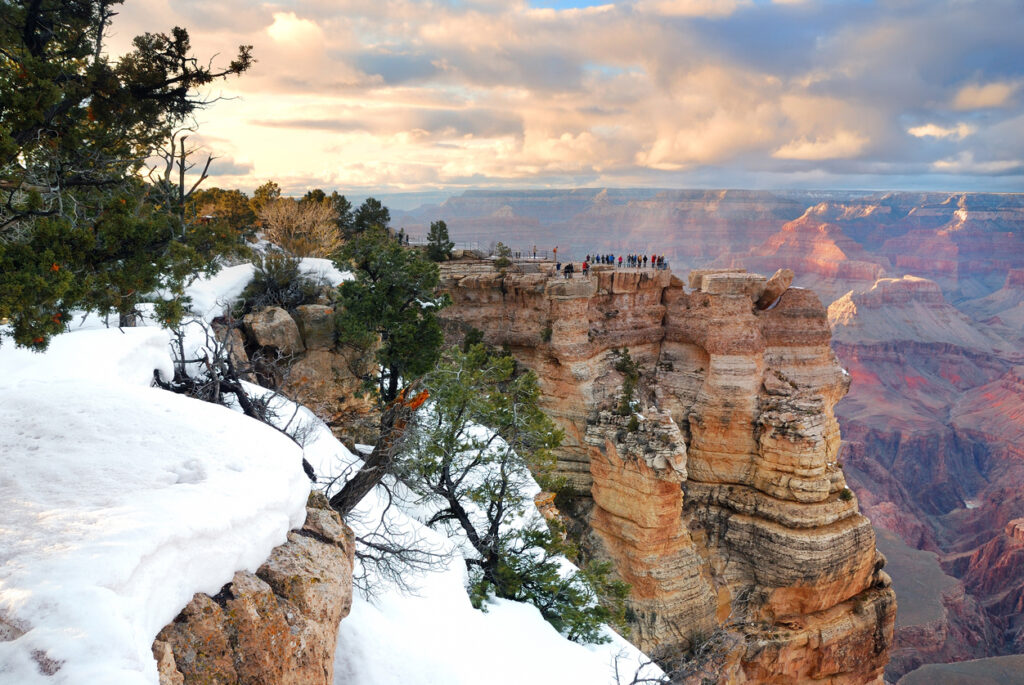
West Rim
You’ll also find a few dining options at the West Rim. For food with a view, Sky View restaurant can’t be beaten with floor-to-ceiling windows overlooking the canyon.
Pro Tip: This casual American restaurant requires general admission tickets to Grand Canyon West – separate from the national park.
In the town of Peach Springs, AZ, Diamond Creek Restaurant in the Hualapai Lodge offers comfort food and local favorites, including delicious frybread and Hualapai tacos.
Inner Canyon
Phantom Ranch Canteen, deep in the bottom of the canyon, is a highly-coveted dining experience that requires a hike or mule ride to the bottom of the canyon (and then back out again).
Reservations are required and are still popular in the winter, though they might be slightly easier to get than during peak season.
COVID Note: There are no sit-down meals in “the near future” and “only to-go breakfasts, sack lunches, and to-go dinners will be available.”
Where to Stay Near the Grand Canyon in Winter
There are plenty of options for camping and lodging in and around Grand Canyon National Park. Camping reservations are recommended, even in winter.
In the Park
Even during the winter months, you can camp in the Grand Canyon National Park. While some campgrounds close in the winter, Mather Campground on the South Rim is open year-round.
Reservations are recommended most of the year and can be made through Recreation.gov, but it is much easier to snag a campsite December-February.
You can get a backcountry permit to camp at Bright Angel Campground at the bottom of the canyon or to winter camp at the North Rim campground.
If you’re not up for winter camping, there are several lodges in Grand Canyon Village on the South Rim that is open year-round, including the Bright Angel Lodge and the El Tovar Hotel.
Even in the winter, it’s a good idea to make lodging reservations in advance if you can.
Outside the Park
The nearby town of Tusayan has many hotel options, ranging from the affordable Red Feather Lodge to the 5-star Grand Hotel at the Grand Canyon. The Best Western Premier Grand Canyon Squire Inn is a great value for the price.
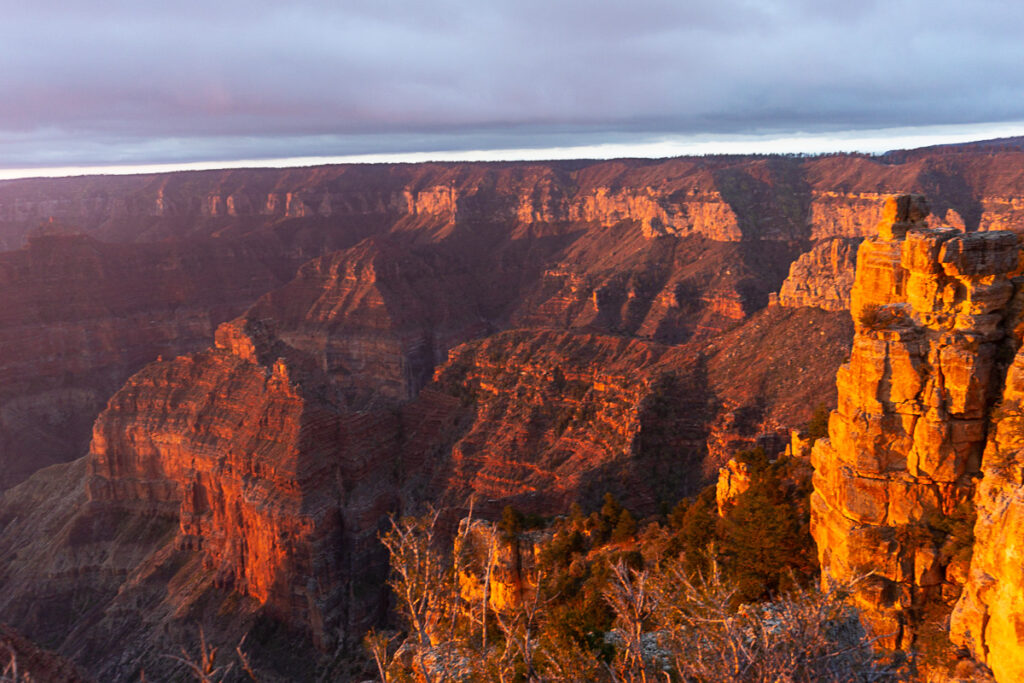
What to Wear for a Winter Trip to the Grand Canyon
The key to being comfortable during the winter in the Grand Canyon is to dress in layers. You’ll want to stay away from cotton, as it’s not a good insulator and when wet, you can get hypothermia.
Here are a few must-have layers for winters at the Grand Canyon.
- Fleece jacket
- Puffy jacket
- Wind breaker
- Gloves
- beanie
- Sunglasses (don’t forget the sunscreen too!)
- Warm socks
- Hiking boots or water proof hiking shoes
- Non-cotton pants
- Lightweight long underwear base layers (you can always shed these by changing in your car).
Additional items you may want to bring with you include:
- Water bottle – plan on drinking 2 – 3 liters per day, more for long, tough hikes
- Plenty of snacks. A pack lunch isn’t a bad idea either
- Thermos filled with your favorite hot beverage
- Small hiking bag
- Microspikes or other traction
- Spare pair of shoes and dry socks for driving around
- Camera with a USB charger
Additional National Parks to Visit in Winter
Wanna get the most of your national parks experience? Winter is an amazing time to check out these fantastic national treasures:
